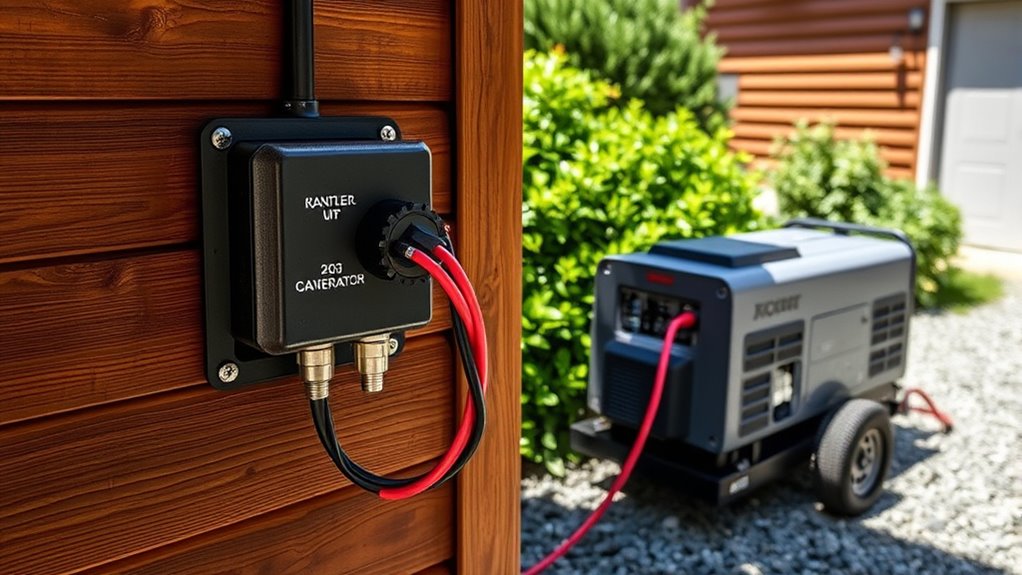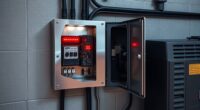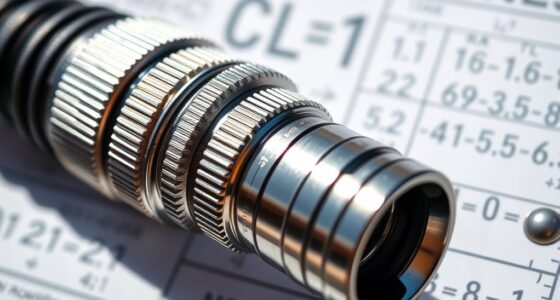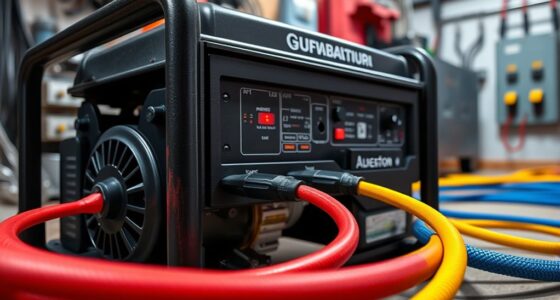To connect a generator to your house with a manual transfer switch, first verify it’s installed correctly by a licensed electrician, following the manufacturer’s instructions. Before a power outage, switch off all appliances and disconnect from utility lines. Connect the generator outdoors in a well-ventilated area, then manually flip the transfer switch to supply power from the generator. Always prioritize safety, and if you keep exploring, you’ll uncover detailed steps to perform this securely.
Key Takeaways
- Install the manual transfer switch according to manufacturer’s instructions or by a licensed electrician to ensure safety and code compliance.
- Prior to connecting the generator, turn off utility power and switch the transfer device to prevent back-feeding.
- Place the generator outdoors in a well-ventilated area, away from windows and doors, to prevent carbon monoxide buildup.
- Connect the generator to the transfer switch using appropriate power cords, and switch the transfer device to generator mode before starting the generator.
- After power is restored, turn off the generator, disconnect it from the transfer switch, and switch back to utility power to ensure safe operation.

When a power outage strikes, having a reliable way to supply electricity to your home becomes essential. A manual transfer switch allows you to connect a generator safely and efficiently, ensuring that your essential appliances and systems stay operational. But before you get started, it’s crucial to understand the importance of electrical safety. Handling electricity improperly can cause serious injury or damage, so taking the right precautions is non-negotiable.
The first step is to install the manual transfer switch correctly. This device allows you to switch your home’s power source from the utility lines to your generator without risking back-feeding, which can be dangerous for utility workers and your equipment. When a power outage occurs, you’ll activate the transfer switch to disconnect your home from the grid and connect it to the generator. This process prevents power from flowing back into the lines, maintaining electrical safety for everyone involved. Proper installation means you should follow the manufacturer’s instructions carefully, or better yet, hire a licensed electrician to do the work. Incorrect installation can lead to shorts, electrical shocks, or fires, especially during a power outage when you’re already under stress.
Once installed, using the manual transfer switch correctly is vital. Before operating your generator, ensure it’s placed outdoors in a well-ventilated area, away from windows and doors to prevent carbon monoxide poisoning. When switching power sources, turn off all connected appliances to avoid overloads, then manually flip the switch to connect your generator. Always confirm that the switch is securely in the correct position before turning on the generator. During operation, keep a close eye on the generator’s functioning—listen for unusual noises, check for overheating, and never run it indoors or in enclosed spaces. This not only keeps your home safe but also preserves the generator’s lifespan. Additionally, understanding security considerations can help you protect your property during outages and ensure peace of mind.
After the power is restored and you’re ready to return to normal, switch the transfer switch back to utility power first, then turn off and disconnect your generator. Proper shutdown procedures are essential to electrical safety because they prevent back-feeding and potential damage. Regular maintenance of your generator and transfer switch, including testing the system periodically, ensures everything works smoothly when you need it most. Remember, a manual transfer switch isn’t just about convenience; it’s about protecting your family, your home, and the utility workers who repair outages. By handling your generator with care and respect, you’ll be prepared to face power outages confidently, knowing that you’ve prioritized electrical safety every step of the way.
Frequently Asked Questions
Can I Install a Manual Transfer Switch Myself?
Yes, you can do a DIY installation of a manual transfer switch, but you must follow safety guidelines closely. Make sure you understand electrical codes, turn off your main power, and read the transfer switch instructions thoroughly. If you’re not confident in your electrical skills, it’s best to hire a licensed electrician. Proper installation guarantees safety, prevents damage, and keeps your home protected during power outages.
How Much Does Professional Installation Typically Cost?
Professional installation typically costs between $200 and $500, depending on your home’s complexity and local rates. It is crucial to compare costs and confirm your electrician meets certification requirements, such as licensing and experience with transfer switches. Investing in certified professionals guarantees safety and proper setup. Remember, a proper installation might be pricier initially but saves you money and trouble in the long run, providing peace of mind during power outages.
What Safety Precautions Should I Take During Installation?
You should wear personal protective equipment like gloves and safety glasses to protect yourself during installation. Make certain proper grounding of the transfer switch to prevent electrical shocks or fires. Turn off the main power before starting, and double-check all connections are secure. Follow manufacturer instructions carefully, and if you’re unsure, hire a professional. Taking these precautions keeps you safe and ensures a proper, safe setup.
How Often Should I Test the Transfer Switch?
You should test your transfer switch at least once a year to guarantee it works properly during power outages. Regular generator maintenance, including transfer switch testing, helps identify potential issues early. Before testing, turn off the generator and follow manufacturer instructions. During the test, confirm that your transfer switch switches seamlessly between power sources, keeping your home safe and your generator ready when needed.
Can I Connect Multiple Generators to One Transfer Switch?
You can connect multiple generators to one transfer switch if they’re compatible and the switch supports it. For example, a homeowner used two small portable generators with a transfer switch designed for multiple inputs, guaranteeing seamless power. Always check generator compatibility and transfer switch types before connecting multiple units. Using a transfer switch rated for multiple sources prevents overloads and ensures safe operation, but consult a professional to avoid any electrical issues.
Conclusion
Connecting a generator with a manual transfer switch is like learning to ride a bike—you’ll feel confident and in control once you’ve mastered the basics. I remember a neighbor who installed his switch and was able to power his home during a blackout, proving the importance of preparation. With the right setup, you’re not just avoiding inconvenience—you’re building resilience. So, take the time to get it right, and you’ll be prepared for whatever comes your way.









